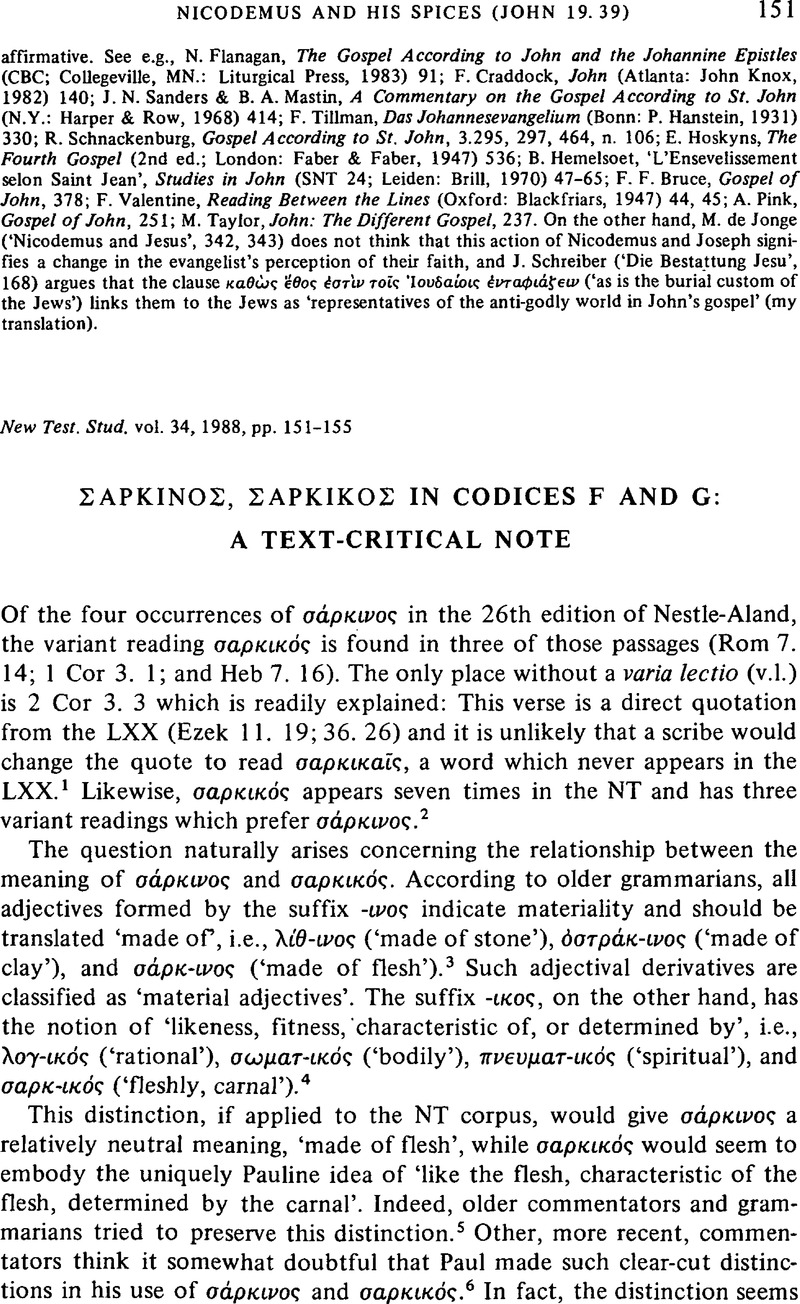No CrossRef data available.
Article contents
ΣАΡΚΙΝΟΣ, ΣАΡΚΙΚΟΣ in codices F and G: A Text-Critical Note
Published online by Cambridge University Press: 05 February 2009
Abstract

- Type
- Short Studies
- Information
- Copyright
- Copyright © Cambridge University Press 1988
References
NOTES
[1] Note, however, that the variant readings for 2 Cor 3. 3 do include a change in the word order, in one instance, and in the case-ending of καρδίαις to καρδίας another.
[2] Of the seven occurrences of σαρκικός (Rom 15. 27; 1 Cor 3. 32, 9. 11; 2 Cor 1. 12, 10. 4; 1 Pet 2. 11) variant readings of σάρκινος are found both times at 1 Cor 3. 3, and 2 Cor 1. 12.
[3] See Robertson, A. T. and Davis, W. Hersey, A New Short Grammar of the Greek Testament (New York: Harper & Bros., 1933) 176.Google Scholar
[4] Robertson, and Davis, , Short Grammar, 176.Google Scholar
[5] See, e.g., Robertson, and Davis, , A Short Grammar, 176Google Scholar, who claimed ‘a sharp distinction exists between the forms in -ικος like and those in -ινος made of …’. See also Robertson, A. T., A Grammar of the Greek New Testament in the Light of Historical Research (Nashville: Broadman, 1934) 158–9.Google ScholarSanday, William and Headlam, Arthur C., A Critical and Exegetical Commentary on the Epistle to the Romans (ICC; Edinburgh: T. & T. Clark, 1914) 181Google Scholar, argued that in Rom 7. 14 σάρκινος ‘denotes simply the material of which human nature is composed, “made of flesh and blood” (1 Cor iii.l; 2 Cor iii.3), and as such exposed to all the temptations which act through the body’. See also, Lightfoot, J. B., Notes on Epistles of St. Paul (Grand Rapids: Baker, 1895, rpt. 1980) 184–5;Google ScholarNygren, Anders, Commentary on Romans (Philadelphia: Fortress, 1949) 299.Google Scholar
[6] See most recent commentaries on any of the Pauline letters, especially Cranfield, C. E. B., The Epistle to the Romans (ICC; Edinburgh: T. & T. Clark, 1975) 1. 357;Google ScholarKäsemann, Ernst, Commentary on Romans (Grand Rapids: Eerdmans, 1980) 199.Google Scholar
[7] Conzelmann, H., 1 Corinthians (Philadelphia: Fortress, 1975) 72.Google Scholar
[8] Barrett, C. K., A Commentary on the First Epistle to the Corinthians (London: A. & C. Black, 1971) 79.Google Scholar
[9] Schweizer, Eduard, ‘σάρξ’, TDNT 7, 144.Google Scholar
[10] Bauer, W., Arndt, W. F., Gingrich, F. W., and Danker, F. W., A Greek-English Lexicon of the New Testament (London: University of Chicago, 1979) 742.Google Scholar
[11] What is odd, however, is that the scribe would harmonize an earlier reading to agree with a later reading. Such is the case for the variant reading in Rom 7. 14. ![]() and the Majority text have the reading σαρκικός at 7. 14. Based on external evidence, this variant is unlikely to have been the original text; it is interesting to the text-critic, however, on a different level. It is possible that the scribes of these later manuscripts altered σάρκινος to σαρκικός in order to harmonize 7. 14 with Rom 15. 27.
and the Majority text have the reading σαρκικός at 7. 14. Based on external evidence, this variant is unlikely to have been the original text; it is interesting to the text-critic, however, on a different level. It is possible that the scribes of these later manuscripts altered σάρκινος to σαρκικός in order to harmonize 7. 14 with Rom 15. 27.
[12] Puzzling still is the fact that in a similar situation F and G allowed σάρκινος to stand in contrast to πνευματικός in Rom 7. 14.
[13] To argue that scribes of an ancestor of Codices F and G, rather than the scribes of those manuscripts themselves, preserved the distinction in meaning of σάρκινος and σαρκικός does not invalidate the conclusions of this study; it merely pushes back the date indeterminately to an earlier period.
[14] See e.g., Epp, Eldon J., The Theological Tendency of Codex Bezae Cantabrigiensis in Acts (Cambridge: Cambridge University, 1966);Google ScholarClark, K. W., ‘The Theological Relevance of Textual Variation in Current Criticism of the Greek New Testament’, JBL 85 (1966) 1–16.Google Scholar See also my article, ‘A Christological Tendency in P75’, JBL 105 (1986) 463–79Google Scholar, in which I argued that the Western non-interpolations of Luke 24 could be explained as a theological Tendenz on the part of the scribes of p75.




